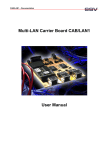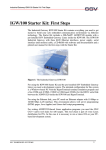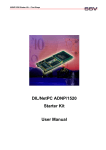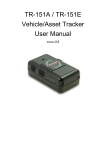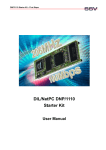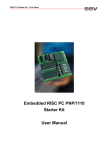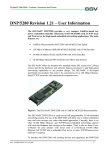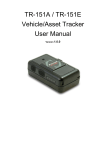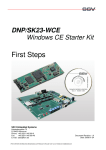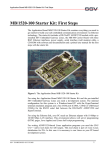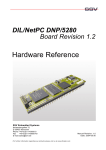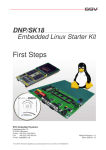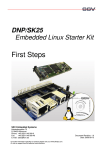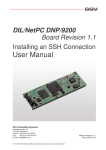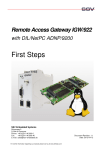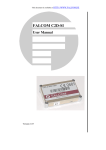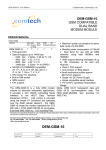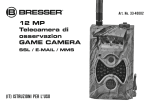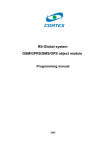Download GPRS Carrier Board CAB/GPRS1 User Manual
Transcript
GPRS Carrier Board – Documentation GPRS Carrier Board CAB/GPRS1 User Manual GPRS Carrier Board – Content Content 1 INTRODUCTION ...........................................................................................................................3 1.1 1.2 1.3 Conventions Used in this Document ..........................................................................................3 Checklist.....................................................................................................................................4 Main Features .............................................................................................................................5 2 BOARD LAYOUT...........................................................................................................................6 3 BOARD COMPONENTS ...............................................................................................................8 3.1 3.2 3.3 3.4 3.5 3.6 3.7 3.8 3.9 3.10 3.11 4 THE GPRS CARRIER BOARD IN USE....................................................................................11 4.1 4.2 4.3 4.4 4.5 4.6 4.7 4.8 4.9 4.10 5 128-pin QIL socket.....................................................................................................................8 GSM/GPRS Modem...................................................................................................................8 Bluetooth Option ........................................................................................................................8 CompactFlash Interface..............................................................................................................9 10/100Mbps Ethernet .................................................................................................................9 CAN-Bus Option........................................................................................................................9 COM Serial Interfaces................................................................................................................9 Onboard Jumper .........................................................................................................................9 LEDs.........................................................................................................................................10 Reset Button .............................................................................................................................10 Power Connector ......................................................................................................................10 Mounting the DIL/NetPC (ADNP/1520) .................................................................................11 Providing with Power...............................................................................................................11 RCM Jumper ............................................................................................................................12 COM Serial Interfaces..............................................................................................................13 Using CompactFlash Cards ......................................................................................................16 Using the GSM/GPRS Modem ................................................................................................18 Using the Bluetooth Option......................................................................................................19 Reset Button .............................................................................................................................20 LEDs.........................................................................................................................................21 Connections ..............................................................................................................................22 APPENDIX ....................................................................................................................................26 SSV EMBEDDED SYSTEMS 2 GPRS Carrier Board – Introduction 1 Introduction The GPRS Carrier Board is an universal carrier board for industrial applications such like process automation, remote support and services. The central element is a modular computer of the DIL/NetPC series. The board offers possibilities to use a GPRS modem as well as an optional module for Bluetooth ® wireless technology or a CompactFlash™ interface. This document describes how to start with the GPRS Carrier Board. For further information about the individual components of this product you may follow the links from our website at: http://www.dilnetpc.com Our Website contains a lot of technical information, which will be updated in regular periods. 1.1 Conventions Used in this Document Convention Usage italic Filenames, as well as Internet addresses such as www.ssvembedded.de italic User inputs, command lines and pathnames bold New terms monospace text Program code Table 1-1: Convention usage SSV EMBEDDED SYSTEMS 3 GPRS Carrier Board – Introduction 1.2 Checklist Compare the content of your GPRS Carrier Board package with the standard checklist below. If any item is missing or appears to be damaged, please contact SSV Embedded Systems. Standard Items • GPRS Carrier Board • DIL/NetPC ADNP/1520 • Null modem cable • Power supply • Power cable • User manual • Support CD-ROM Optional Items • ISP adapter (Bluetooth option only) Please note that SSV does not include a Bluetooth or GSM/GPRS antenna. SSV EMBEDDED SYSTEMS 4 GPRS Carrier Board – Introduction 1.3 Main Features GPRS Carrier Board • 128-pin QIL socket for one DIL/NetPC (like the ADNP/1520) • 10/100Base-T Ethernet Interface • RS232 Serial interface (COM1) • RS232/422/485 Serial interfaces (COM2 and COM3) • In-System Programming interface (Bluetooth option only) • HF-Out interface to connect an external antenna (Bluetooth option only) • Dual Band GSM/GPRS modem E-GSM 900/1800 • RF connector type MMCX (Miniature Micro Connector) to connect an external GSM/GPRS antenna • CAN-bus interface (only with DNP/5280) • CompactFlash card interface • 6 LEDs • 1 Reset switch • 5VDC Power Input Connector • Size 180 x 100 mm DIL/NetPC ADNP/1520 (standard) • AMD™ SC520 CPU with 133 MHz Clock Speed and FPU • 32/64 MByte SDRAM Memory • 16 MByte Flash Memory • 10/100Mbps Ethernet Interface • Real Time Clock • IDE Support • Two 16C550 UART Serial Ports • 20-bit General Purpose High-Speed Parallel I/O • 7 Interrupt Inputs, 4 Chip Select Outputs • In-System Programming Features • 128-pin QIL connector • 3.3 Volt Low Power Design, Single 3.3 VDC Supply • Size 82 x 36 mm SSV EMBEDDED SYSTEMS 5 GPRS Carrier Board – Board Layout 2 Board Layout The design of your GPRS Carrier Board depends on the DIL/NetPC and the Bluetooth option. Therefore some components like the ISP connector, the Bluetooth chipset, the antenna connector, or the CAN-bus interface may not be mounted on your board. Figure 2-1: Top view of GPRS Carrier Board Figure 2-2: Bottom view of GPRS Carrier Board SSV EMBEDDED SYSTEMS 6 GPRS Carrier Board – Board Layout Figure 2-3: Wavecom® Integra® GSM/GPRS modem Figure 2-4: SIM card slot and MMCX antenna connector SSV EMBEDDED SYSTEMS 7 GPRS Carrier Board – Board Components 3 Board Components 3.1 128-pin QIL socket The QIL socket with 128 pins can hold one DIL/NetPC like the ADNP/1520. Please refer to chapter 4.1 how to mount your DIL/NetPC safely. If you are interested in pin signals please refer to the appendix. 3.2 GSM/GPRS Modem The board contains a GSM/GPRS modem made by Wavecom®. Some basic features are: 3.3 • Dual Band integrated GSM modem (EGSM900/1800 MHz) • Fully Type Approved • Compliant with ETSI GSM Phase 2+ standard (Normal MS) • Class 4 (2W at 900 MHz) • Class 1 (1W at 1800 MHz) • MMCX antenna connector for 900 and 1800 MHz • Internal 3V SIM reader (5V SIM with external level shifter) Bluetooth Option The Bluetooth technology is a standard for short-range wireless communications between different devices. The module option on the carrier board is a complete baseband/RF solution that allows you a quick and easy integration of Bluetooth wireless technology outgoing from Handheld, PDA, Cell Phone or Laptop into embedded or standard devices. The Bluetooth option follows the Bluetooth standard with all its included advantages like transmission security and noise immunity in the industrial environment area. The onboard Bluetooth module allows the connection between the ADNP/1520 and other devices via Bluetooth. To use all features offered by the Bluetooth module it is necessary to connect a standard Bluetooth antenna to the GPRS Carrier Board. For this, any standard 2.4 GHz Bluetooth antenna with an impedance of 50 ohm and SMA connector can be used with the HF-out connector. The GPRS Carrier Board offers an ISP interface. This interface is used to communicate with the onboard Bluetooth module, e.g. to load a new firmware. SSV EMBEDDED SYSTEMS 8 GPRS Carrier Board – Board Components 3.4 CompactFlash Interface On the back side of the GPRS Carrier Board a CompactFlash interface is located, that will operate with 3.3V. 3.5 10/100Mbps Ethernet The ADNP/1520 is using an SMSC™ LAN91C111 chip that allows Ethernet connectivity with a speed up to 100Mbps. The RJ45 Ethernet interface on the GPRS Carrier Board is just a simple connection over a transformer to the 128 QIL interface pins, which are connected to the SMSC LAN controller on the ADNP/1520. 3.6 CAN-Bus Option The GPRS carrier board offers a CAN-bus option. The CAN-bus interface will be available if using the DIL/NetPC DNP/5280. 3.7 COM Serial Interfaces The GPRS Carrier Board is equipped with 3 serial COM interfaces: COM1 (9-pin sub-D male connector), COM2 (10-pin boxed header), and COM3 (9-pin sub-D male connector). COM1 is used for initial communication with the carrier board. It follows the RS232 protocol. COM2 can either be used with RS232 TTL level or with the RS232, RS485 or RS422 protocol. COM3 can be used with the RS232, RS485 or RS 422 protocol. 3.8 Onboard Jumper JP1: JP2/3: JP4 - JP8 JP9 - JP13 JP14/15 SSV EMBEDDED SYSTEMS RCM jumper for terminal mode Chip select (CS) jumper Jumper field for setting COM2 to RS232/RS485/RS422 Jumper field for setting COM3 to RS232/RS485/RS422 Jumpers for using the ISP interface (Bluetooth option only) 9 GPRS Carrier Board – Board Components 3.9 LEDs You will find 6 LEDs on your GPRS Carrier Board, which are illustrated in figure 3-1. Figure 3-1: LEDs 3.10 Reset Button Press the reset button if the system hangs or you need to restart it. Pressing the reset button will only restart the ADNP/1520. To reset connected devices, turn off power from the system. 3.11 Power Connector Caution: Providing the GPRS Carrier Board with a voltage higher than the regular 5V DC ±10% could resolve in damaged board components. The GPRS Carrier Board needs a supply voltage of 5V DC to work. In your carrier board package you will find a plug-in power supply unit to provide the system with the necessary power. SSV EMBEDDED SYSTEMS 10 GPRS Carrier Board – The GPRS Carrier Board in Use 4 The GPRS Carrier Board in Use 4.1 Mounting the DIL/NetPC (ADNP/1520) Caution: Too high pressure on the DIL/NetPC can resolve in damaged components and/or in bent or broken pins. To mount the ADNP/1520 on the GPRS Carrier Board set it carefully on the 128pin QIL socket. Please note, that the ADNP/1520 is positioned in the right way as shown in figure 4-1. After that, press the ADNP/1520 carefully down, so that the QIL socket fixes it. Figure 4-1: Mounting the ADNP/1520 on the GPRS Carrier Board 4.2 Providing with Power Caution: Providing the Carrier Board with a voltage higher than the regular 5V DC ±10% could resolve in damaged board components. Caution: SSV recommends to power off the GPRS carrier board every time you alter or modify board configurations like jumper settings or cable connections. The GPRS Carrier Board needs a supply voltage of 5VDC to work. In your carrier board package you will find a plug-in power supply unit to provide the system with the necessary power. SSV EMBEDDED SYSTEMS 11 GPRS Carrier Board – The GPRS Carrier Board in Use 4.3 RCM Jumper Use this jumper to activate the RCM mode of the ADNP/1520. The RCM mode (Remote Console Mode) offers the possibility to control the ADNP/1520 via terminal program. To activate the RCM mode place a jumper cap on both pins of the RCM jumper, so that it is short. If you remove the jumper cap, or place the jumper cap on just one pin, the jumper is open and you can not use the RCM mode.When closed you will see some boot messages on the serial port COM1. If the RCM jumper is open, these messages are blocked. Figure 4-2 shows the exact position of the RCM jumper. Figure 4-2: RCM jumper RCM mode enabled SSV EMBEDDED SYSTEMS RCM mode disabled 12 GPRS Carrier Board – The GPRS Carrier Board in Use 4.4 COM Serial Interfaces 4.4.1 COM1 Serial Interface COM1 is mostly used for initial communication with the carrier board and follows the RS232 protocol. The interface has a 9-pin sub-D male connector. When using a remote terminal on this port, make sure the RCM jumper is set (see chapter 4.3). 4.4.2 COM2 Serial Interfaces Attention: Use only one COM2 serial interface at the same time. Use a TTL level adapter when using the TTL level COM2 interface. COM2 can either be used with RS232 TTL level or with the RS232, RS485 or RS422 protocol. The RS232 TTL level interface has got a 10-pin boxed header. The second COM2 port on the board has also a boxed header. In addition the protocol (RS232, RS485, or RS422) can be set by jumpers for this interface. Figure 4-3: COM2 interfaces SSV EMBEDDED SYSTEMS 13 GPRS Carrier Board – The GPRS Carrier Board in Use With jumpers JP4 to JP8 the COM2 protocol can be set as shown in figure 4-4. Figure 4-4: COM2 jumper field COM2 RS232 COM2 RS485 COM2 RS422 Jumper JP8 is used as termination jumper (default = off). To use termination, three optional resistors have to be onboard. Set the JP8 jumper cap on pins 1 and 2 to terminate the COM2 interface for RS485 and RS422 mode. In RS232 mode the COM2 interface can not be terminated. SSV EMBEDDED SYSTEMS 14 GPRS Carrier Board – The GPRS Carrier Board in Use 4.4.3 COM3 Serial Interface COM3 can be used with RS232, RS485 or RS 422 protocol. It has a 9-pin sub-D male connector. The COM3 protocols can be set by jumpers JP9 to JP13 as shown below. Figure 4-5: COM3 jumper field COM3 RS232 COM3 RS485 COM3 RS422 Jumper JP13 is used as termination jumper (default = off). To use termination, three optional resistors have to be onboard. Set the JP13 jumper cap on pins 1 and 2 to terminate the COM3 interface for RS485 and RS422 mode. In RS232 mode the COM3 interface can not be terminated. SSV EMBEDDED SYSTEMS 15 GPRS Carrier Board – The GPRS Carrier Board in Use 4.5 Using CompactFlash Cards 4.5.1 Jumper Settings Attention: Using the Bluetooth option is not possible when using the CompactFlash interface simultaneously. To use the CompactFlash card interface it is required to set jumpers JP2 and JP3 to the right positions as shown below. Figure 4-6: Jumpers JP2 and JP3 CompactFlash interface enabled SSV EMBEDDED SYSTEMS 16 GPRS Carrier Board – The GPRS Carrier Board in Use 4.5.2 CompactFlash Cards Insert your CompactFlash card (CF card) as shown in the figure below. Use only CompactFlash cards of type I. Cards of type II will not mount into the CompactFlash slot. Make sure, the card is face-up. Otherwise it will not mount into the slot. Figure 4-7: Using CompactFlash cards (bottom view of GPRS Carrier Board) SSV EMBEDDED SYSTEMS 17 GPRS Carrier Board – The GPRS Carrier Board in Use 4.6 Using the GSM/GPRS Modem 4.6.1 GSM/GPRS Antenna The Integra Wavecom GSM/GPRS modem has an MMCX connector to hold an antenna. Please refer to the antenna manual how to safely mount and use it. 4.6.2 SIM Card Push in the pin lever with e.g. a ballpoint pen to open the SIM card slot of the GSM/GPRS modem. Take out the card sledge and insert your SIM card appropriately. Push the card sledge back into the modem softly. Figure 4-8: Insertion of a SIM card SSV EMBEDDED SYSTEMS 18 GPRS Carrier Board – The GPRS Carrier Board in Use 4.7 Using the Bluetooth Option 4.7.1 Jumper Settings Attention: Using the Bluetooth option is not possible when using the CompactFlash interface simultaneously. To use the Bluetooth module it is required to set jumpers JP2 and JP3 to the positions as shown below. Figure 4-9: Jumpers JP2 and JP3 Bluetooth module enabled 4.7.2 Antenna The optional onboard Bluetooth module allows the connection between the ADNP/1520 and other devices via Bluetooth. To use all features offered by the Bluetooth module it is necessary to connect a standard Bluetooth antenna to the GPRS Carrier Board. For this, any standard 2.4 GHz Bluetooth antenna with an impedance of 50 ohm and SMA connector can be used with the HF-out connector. Please refer to your antenna manual how to safely mount and use it. SSV EMBEDDED SYSTEMS 19 GPRS Carrier Board – The GPRS Carrier Board in Use Figure 4-10: Bluetooth antenna 4.8 Reset Button Press the reset button if the system hangs or you need to restart it. Pressing the reset button will only restart the ADNP/1520. To reset any connected devices turn off power from the system. SSV EMBEDDED SYSTEMS 20 GPRS Carrier Board – The GPRS Carrier Board in Use 4.9 LEDs Six LEDs are placed on your GPRS carrier board: Power-LED This LED lights when the board is powered. The baseband activity LED flickers or lights up if there is some Bluetooth Baseband Activity traffic via the Bluetooth interface. GPRS Flashing The GPRS flashing LED flickers or lights up if there is some traffic via the GPRS/GSM modem. ADNP PORT A/0 PORT A/1 PORT A/2 The function of these LEDs are user definable. Table 4-1: LEDs Figure 4-11: LEDs SSV EMBEDDED SYSTEMS 21 GPRS Carrier Board – The GPRS Carrier Board in Use 4.10 Connections In addition to Bluetooth and GPRS/GSM connections several cable connections can be made to your GPRS carrier board. In the following subchapters three types of connections are described. 4.10.1 Serial Link For an initial communication with the GPRS carrier board use a null modem cable on port COM1. For the serial link, you need a null modem cable. This cable comes along with your GPRS Carrier Board package. Please connect the GPRS Carrier Board with a COM port of your development system (for example COM1 or COM2) by using this cable. Figure 4-12: Serial link SSV EMBEDDED SYSTEMS 22 GPRS Carrier Board – The GPRS Carrier Board in Use 4.10.2 Ethernet Link The Ethernet link requires two standard 10 Base-T patch cables, one hub or switch and an Ethernet LAN adapter for your development system. Figure 4-13: Ethernet link with hub or switch If you want to connect your development system directly to the GPRS Carrier Board place a crossover cable between these two systems as shown in figure 4-14. Figure 4-14: Ethernet link with crossover cable SSV EMBEDDED SYSTEMS 23 GPRS Carrier Board – The GPRS Carrier Board in Use 4.10.3 ISP Link Caution: The ISP interface uses TTL levels. To connect it to a standard RS232 serial port a special adapter which converts the TTL level to standard RS232 level is necessary. This optional adapter can be delivered on request. To provide the optional Bluetooth module with another firmware an adapter is needed. This adapter converts the RS232 signal levels provided by the development system into TTL signal levels which are needed by the Bluetooth module on the Carrier Board. The figure below shows the cable connection to transfer data to the Bluetooth module via the ISP link. Figure 4-15: ISP link SSV EMBEDDED SYSTEMS 24 GPRS Carrier Board – The GPRS Carrier Board in Use ISP Jumper Field Use the jumpers JP14 and JP15 to activate the ISP-interface (In-System Programming). With the ISP interface it is possible to upgrade the firmware of the Bluetooth module (option). Figure 4-16: ISP jumper field Jumper positions for connecting the ISP adapter to the Bluetooth module SSV EMBEDDED SYSTEMS Jumper positions for normal communication between the onboard UART and the Bluetooth module 25 GPRS Carrier Board – Appendix 5 Appendix The Appendices give you more detailed information about the signals on the individual connectors. Table cells marked with NC indicate signals, which may be not connected. Appendix 1: Pin Assignment – 128-pin QIL Connector (1st Part) Pin 1 2 3 4 5 6 7 8 9 10 11 12 13 14 15 16 17 18 19 20 21 22 23 24 25 26 27 28 29 30 31 32 Name PA0 PA1 PA2 PA3 PA4 PA5 PA6 PA7 PB0 PB1 PB2 PB3 PB4 PB5 PB6 PB7 PC0 PC1 PC2 PC3 RXD1 TXD1 CTS1 RTS1 DCD1 DSR1 DTR1 RI1 RESIN TX+ TXGND Group PIO PIO PIO PIO PIO PIO PIO PIO PIO PIO PIO PIO PIO PIO PIO PIO PIO PIO PIO PIO SIO SIO SIO SIO SIO SIO SIO SIO RESET LAN LAN ---- Function Parallel I/O, Port A, Bit 0 * Parallel I/O, Port A, Bit 1* Parallel I/O, Port A, Bit 2* Parallel I/O, Port A, Bit 3* Parallel I/O, Port A, Bit 4* Parallel I/O, Port A, Bit 5* Parallel I/O, Port A, Bit 6* Parallel I/O, Port A, Bit 7* Parallel I/O, Port B, Bit 0* Parallel I/O, Port B, Bit 1* Parallel I/O, Port B, Bit 2* Parallel I/O, Port B, Bit 3* Parallel I/O, Port B, Bit 4* Parallel I/O, Port B, Bit 5* Parallel I/O, Port B, Bit 6* Parallel I/O, Port B, Bit 7* Parallel I/O, Port C, Bit 0* Parallel I/O, Port C, Bit 1* Parallel I/O, Port C, Bit 2* Parallel I/O, Port C, Bit 3* COM1 Serial Port, RXD Pin COM1 Serial Port, TXD Pin COM1 Serial Port, CTS Pin COM1 Serial Port, RTS Pin COM1 Serial Port, DCD Pin COM1 Serial Port, DSR Pin COM1 Serial Port, DTR Pin COM1 Serial Port, RI Pin Reset Input Ethernet Interface, TX+ Pin Ethernet Interface, TX- Pin Ground Table A1-1: ADNP/1520 pinout – pin 1 to 32 The PIO pins 1 to 20 are driven by an in-system programmable (ISP) high density PLD (ispMACH256 or similar). It is possible to change the function of these pins over the ADNP/1520 JTAG interface. Please contact our support staff for more information. SSV EMBEDDED SYSTEMS 26 GPRS Carrier Board – Appendix Appendix 1: Pin Assignment – 128-pin QIL Connector (2nd Part) Pin 33 34 35 36 37 38 39 40 41 42 43 44 45 46 47 48 49 50 51 52 53 54 55 56 57 58 59 60 61 62 63 64 Name RX+ RXRESOUT VBAT CLKOUT TXD2 RXD2 INT5 INT4 INT3 INT2 INT1 CS4 CS3 CS2 CS1 IOCHRDY IOR IOW SA3 SA2 SA1 SA0 SD7 SD6 SD5 SD4 SD3 SD2 SD1 SD0 Vcc Group LAN LAN RESET PSP PSP PSP PSP PSP PSP PSP PSP PSP PSP PSP PSP PSP PSP PSP PSP PSP PSP PSP PSP PSP PSP PSP PSP PSP PSP PSP PSP PSP Function Ethernet Interface, RX+ Pin Ethernet Interface, RX- Pin Reset Output SC520 Real Time Clock Battery Input Clock Output (Default 1.8432 MHz) COM2 Serial Port, TXD Pin COM2 Serial Port, RXD Pin Programmable Interrupt Input 5 Programmable Interrupt Input 4 Programmable Interrupt Input 3 Programmable Interrupt Input 2 Programmable Interrupt Input 1 Programmable Chip Select Output 4 Programmable Chip Select Output Programmable Chip Select Output 2 Programmable Chip Select Output 1 I/O Channel Ready I/O Read Signal, I/O Expansion Bus I/O Write Signal, I/O Expansion Bus System Expansion Bus, Address Bit 3 System Expansion Bus, Address Bit 2 System Expansion Bus, Address Bit 1 System Expansion Bus, Address Bit 0 System Expansion Bus, Data Bit 7 System Expansion Bus, Data Bit 6 System Expansion Bus, Data Bit 5 System Expansion Bus, Data Bit 4 System Expansion Bus, Data Bit 3 System Expansion Bus, Data Bit 2 System Expansion Bus, Data Bit 1 System Expansion Bus, Data Bit 0 3.3 Volt Power Input Table A1-2: ADNP/1520 pinout – pin 33 to 64 SSV EMBEDDED SYSTEMS 27 GPRS Carrier Board – Appendix Appendix 1: Pin Assignment –128-pin QIL Connector (3rd Part) Pin 65 66 67 68 69 70 71 72 73 74 75 76 77 78 79 80 81 82 83 84 85 86 87 88 89 90 91 92 93 94 95 96 Name SBHE IOCS16 MEMCS16 MEMW MEMR BALE AEN Reserved RCME Reserved Reserved Reserved Reserved Reserved Reserved Reserved Reserved Reserved Reserved Reserved INT6 INT7 IDERES IDECS0 IDECS1 Reserved Reserved Reserved Reserved Reserved Reserved GND Group PSP PSP PSP PSP PSP PSP PSP PSP PSP PSP PSP PSP PSP PSP PSP PSP PSP PSP PSP PSP PSP PSP PSP PSP PSP PSP PSP PSP PSP PSP PSP --- Function System Byte High Enable, Sys. Exp. Bus I/O Chip Select 16, Sys. Expansion Bus Memory Chip Select 16, Sys. Exp. Bus Memory Write Signal, Sys. Expansion Bus Memory Read Signal, Sys. Expansion Bus Bus Address Latch Enable, Sys. Exp. Bus Address Enable Signal, Sys. Expansion Bus Reserved. Don’t use Remote Console Mode Enable Reserved. Don’t use Reserved. Don’t use Reserved. Don’t use Reserved. Don’t use Reserved. Don’t use Reserved. Don’t use Reserved. Don’t use Reserved. Don’t use Reserved. Don’t use Reserved. Don’t use Reserved. Don’t use Programmable Interrupt Input 6 Programmable Interrupt Input 7 IDE Interface Reset Output IDE Interface Chip Select 0 IDE Interface Chip Select 1 Reserved. Don’t use Reserved. Don’t use Reserved. Don’t use Reserved. Don’t use Reserved. Don’t use Reserved. Don’t use Ground Table A1-3: ADNP/1520 pinout – pin 65 to 96 SSV EMBEDDED SYSTEMS 28 GPRS Carrier Board – Appendix Appendix 1: Pin Assignment –128-pin QIL Connector (4th Part) Pin 97 98 99 100 101 102 103 104 105 106 107 108 109 110 111 112 113 114 115 116 117 118 119 120 121 122 123 124 125 126 127 128 Name LANLED Reserved RSTDRV SA23 SA22 SA21 SA20 SA19 SA18 SA17 SA16 SA15 SA14 SA13 SA12 SA11 SA10 SA9 SA8 SA7 SA6 SA5 SA4 SD15 SD14 SD13 SD12 SD11 SD10 SD9 SD8 Vcc Group PSP PSP PSP PSP PSP PSP PSP PSP PSP PSP PSP PSP PSP PSP PSP PSP PSP PSP PSP PSP PSP PSP PSP PSP PSP PSP PSP PSP PSP PSP PSP --- Function LAN Interface Activity LED Reserved. Don’t use Reset Output, System Expansion Bus System Expansion Bus, Address Bit 23 System Expansion Bus, Address Bit 22 System Expansion Bus, Address Bit 21 System Expansion Bus, Address Bit 20 System Expansion Bus, Address Bit 19 System Expansion Bus, Address Bit 18 System Expansion Bus, Address Bit 17 System Expansion Bus, Address Bit 16 System Expansion Bus, Address Bit 15 System Expansion Bus, Address Bit 14 System Expansion Bus, Address Bit 13 System Expansion Bus, Address Bit 12 System Expansion Bus, Address Bit 11 System Expansion Bus, Address Bit 10 System Expansion Bus, Address Bit 9 System Expansion Bus, Address Bit 8 System Expansion Bus, Address Bit 7 System Expansion Bus, Address Bit 6 System Expansion Bus, Address Bit 5 System Expansion Bus, Address Bit 4 System Expansion Bus, Data Bit 15 System Expansion Bus, Data Bit 14 System Expansion Bus, Data Bit 13 System Expansion Bus, Data Bit 12 System Expansion Bus, Data Bit 11 System Expansion Bus, Data Bit 10 System Expansion Bus, Data Bit 9 System Expansion Bus, Data Bit 8 3.3 Volt Power Input Table A1-4: ADNP/1520 pinout - pin 97 to 128 SSV EMBEDDED SYSTEMS 29 GPRS Carrier Board – Appendix Appendix 2: Pin Assignment of Components COM1 Connector (RS232 Only) Pin 1 2 3 4 5 Signal DCD RXD TXD DTR GND Pin 6 7 8 9 Signal DSR RTS CTS RI Table A2-1: Pinout COM1 (RS232) connector COM2 Connectors (RS232/RS422/RS485) Pin 1 2 3 4 5 Signal DCD RXD TXD DTR GND Pin 6 7 8 9 Signal DSR RTS CTS RI Table A2-2: Pinout COM2 (RS232) connectors Pin 1 2 3 4 5 Signal reserved TX+ TXreserved GND Pin 6 7 8 9 Signal RX+ RXreserved reserved Table A2-3: Pinout COM2 (RS422) connectors Pin 1 2 3 4 5 Signal reserved RX+/TX+ RX+/TX+ reserved GND Pin 6 7 8 9 Signal RX-/TXRX-/TXreserved reserved Table A2-4: Pinout COM2 (RS485) connectors SSV EMBEDDED SYSTEMS 30 GPRS Carrier Board – Appendix COM3 Connector (RS232/RS422/RS485) Pin 1 2 3 4 5 Signal DCD RXD TXD DTR GND Pin 6 7 8 9 Signal DSR RTS CTS RI Table A2-5: Pinout COM3 (RS232) connector Pin 1 2 3 4 5 Signal reserved TX+ TXreserved GND Pin 6 7 8 9 Signal RX+ RXreserved reserved Table A2-6: Pinout COM3 (RS422) connector Pin 1 2 3 4 5 Signal reserved RX+/TX+ RX+/TX+ reserved GND Pin 6 7 8 9 Signal RX-/TXRX-/TXreserved reserved Table A2-7: Pinout COM3 (RS485) connector SSV EMBEDDED SYSTEMS 31 GPRS Carrier Board – Appendix ISP Connector Pin 1 2 3 4 5 Signal RXD TXD GND Pin 6 7 8 9 10 Signal RTS CTS Vcc Table A2-8: Pinout ISP connector CAN-Bus Connector Pin 1 2 3 4 5 Signal GND CAN-L CAN-H GND Pin Signal 6 7 8 9 10 Table A2-9: Pinout CAN-bus connector Power Connector Pin 1 2 3 Name Vcc GND GND Signal Power In PowerPower Table A2-10: Pinout power connector SSV EMBEDDED SYSTEMS 32 GPRS Carrier Board – Appendix CompactFlash Connector Pin 1 2 3 4 5 6 7 8 9 10 11 12 13 14 15 16 17 18 19 20 21 22 23 24 25 Signal GND D3 D4 D5 D6 D7 /CS0 A10 /ATASEL A9 A8 A7 VCC A6 A5 A4 A3 A2 A1 A0 D0 D1 D2 /IOCS16 /CD2 Pin 26 27 28 29 30 31 32 33 34 35 36 37 38 39 40 41 42 43 44 45 46 47 48 49 50 Signal /CD1 D11 D12 D13 D14 D15 /CS1 /VS1 /IOR /IOW /WE IRQ VCC /CSEL VS2 RESET /WAIT /INPACK /REG /DASP /PDIAG D8 D9 D10 GND Table A2-11: Pinout CompactFlash connector 10/100 Mbps Ethernet Connector Pin 1 2 3 4 5 6 7 8 S1..2 Name TX+ TXRX+ NC NC RXNC NC Shield Signal TXD+ TXDRXD+ – – RXD– – – Table A2-12: Pinout 10/100 Mbps Ethernet connector SSV EMBEDDED SYSTEMS 33 GPRS Carrier Board – Appendix List of Figures FIGURE 2-1: TOP VIEW OF GPRS CARRIER BOARD.................................................................6 FIGURE 2-2: BOTTOM VIEW OF GPRS CARRIER BOARD .......................................................6 FIGURE 2-3: WAVECOM® INTEGRA® GSM/GPRS MODEM ...................................................7 FIGURE 2-4: SIM CARD SLOT AND MMCX ANTENNA CONNECTOR...................................7 FIGURE 3-1: LEDS ..............................................................................................................................10 FIGURE 4-1: MOUNTING THE ADNP/1520 ON THE GPRS CARRIER BOARD....................11 FIGURE 4-2: RCM JUMPER .............................................................................................................12 FIGURE 4-3: COM2 INTERFACES..................................................................................................13 FIGURE 4-4: COM2 JUMPER FIELD..............................................................................................14 FIGURE 4-5: COM3 JUMPER FIELD..............................................................................................15 FIGURE 4-6: JUMPERS JP2 AND JP3 .............................................................................................16 FIGURE 4-7: USING COMPACTFLASH CARDS (BOTTOM VIEW OF GPRS CARRIER BOARD).................................................................................................................................................17 FIGURE 4-8: INSERTION OF A SIM CARD ..................................................................................18 FIGURE 4-9: JUMPERS JP2 AND JP3 .............................................................................................19 FIGURE 4-10: BLUETOOTH ANTENNA ........................................................................................20 FIGURE 4-11: LEDS ............................................................................................................................21 FIGURE 4-12: SERIAL LINK ............................................................................................................22 FIGURE 4-13: ETHERNET LINK WITH HUB OR SWITCH.......................................................23 FIGURE 4-14: ETHERNET LINK WITH CROSSOVER CABLE ................................................23 FIGURE 4-15: ISP LINK .....................................................................................................................24 FIGURE 4-16: ISP JUMPER FIELD .................................................................................................25 SSV EMBEDDED SYSTEMS 34 GPRS Carrier Board – Appendix List of Tables TABLE 1-1: CONVENTION USAGE ..................................................................................................3 TABLE 4-1: LEDS ................................................................................................................................21 TABLE A1-1: ADNP/1520 PINOUT – PIN 1 TO 32 .........................................................................26 TABLE A1-2: ADNP/1520 PINOUT – PIN 33 TO 64 .......................................................................27 TABLE A1-3: ADNP/1520 PINOUT – PIN 65 TO 96 .......................................................................28 TABLE A1-4: ADNP/1520 PINOUT - PIN 97 TO 128......................................................................29 TABLE A2-1: PINOUT COM1 (RS232) CONNECTOR .................................................................30 TABLE A2-2: PINOUT COM2 (RS232) CONNECTORS ...............................................................30 TABLE A2-3: PINOUT COM2 (RS422) CONNECTORS ...............................................................30 TABLE A2-4: PINOUT COM2 (RS485) CONNECTORS ...............................................................30 TABLE A2-5: PINOUT COM3 (RS232) CONNECTOR .................................................................31 TABLE A2-6: PINOUT COM3 (RS422) CONNECTOR .................................................................31 TABLE A2-7: PINOUT COM3 (RS485) CONNECTOR .................................................................31 TABLE A2-8: PINOUT ISP CONNECTOR......................................................................................32 TABLE A2-9: PINOUT CAN-BUS CONNECTOR ..........................................................................32 TABLE A2-10: PINOUT POWER CONNECTOR...........................................................................32 TABLE A2-11: PINOUT COMPACTFLASH CONNECTOR ........................................................33 TABLE A2-12: PINOUT 10/100 MBPS ETHERNET CONNECTOR............................................33 SSV EMBEDDED SYSTEMS 35 GPRS Carrier Board – Appendix List of Appendices APPENDIX 1: PIN ASSIGNMENT – 128-PIN QIL CONNECTOR (1ST PART) .........................26 APPENDIX 1: PIN ASSIGNMENT – 128-PIN QIL CONNECTOR (2ND PART).........................27 APPENDIX 1: PIN ASSIGNMENT –128-PIN QIL CONNECTOR (3RD PART)..........................28 APPENDIX 1: PIN ASSIGNMENT –128-PIN QIL CONNECTOR (4TH PART)..........................29 APPENDIX 2: PIN ASSIGNMENT OF COMPONENTS................................................................30 LIST OF FIGURES ..............................................................................................................................34 LIST OF TABLES ................................................................................................................................35 LIST OF TABLES ................................................................................................................................35 LIST OF APPENDICES ......................................................................................................................36 LIST OF APPENDICES ......................................................................................................................36 CONTACT.............................................................................................................................................37 TRADEMARK ANNOTATIONS .......................................................................................................37 DOCUMENT HISTORY .....................................................................................................................37 SSV EMBEDDED SYSTEMS 36 GPRS Carrier Board – Appendix Contact SSV Embedded Systems Heisterbergallee 72 D-30453 Hannover Tel. +49-(0)511-40000-0 Fax. +49-(0)511-40000-40 e-mail: [email protected] Web: www.dilnetpc.com Trademark Annotations The Bluetooth® word mark and logos are owned by the Bluetooth SIG, Inc. The CompactFlash®, CFA(logo) and CF(logo) are owned by the CompactFlash Association (CFA). Wavecom®, WISMO® and Integra® are trademarks of Wavecom S.A. AMD, the AMD logo, and combinations thereof are trademarks of Advanced Micro Devices, Inc. Standard Microsystems and SMSC are registered trademarks of Standard Microsystems Corporation. Other word marks and logos are owned by their respective holders. Document History Revision Date Name 1.00 30.07.03 First Version BKA 1.01 06.08.03 Minor corrections BKA This document is written only for the internal application. The contents of this document can change any time without announcement. There is taken over no guarantee for the accuracy of the statements. Copyright © SSV EMBEDDED SYSTEMS 2003. All rights reserved. INFORMATION PROVIDED IN THIS DOCUMENT IS PROVIDED 'AS IS' WITHOUT WARRANTY OF ANY KIND. The user assumes the entire risk as to the accuracy and the use of this document. SSV EMBEDDED SYSTEMS 37





































